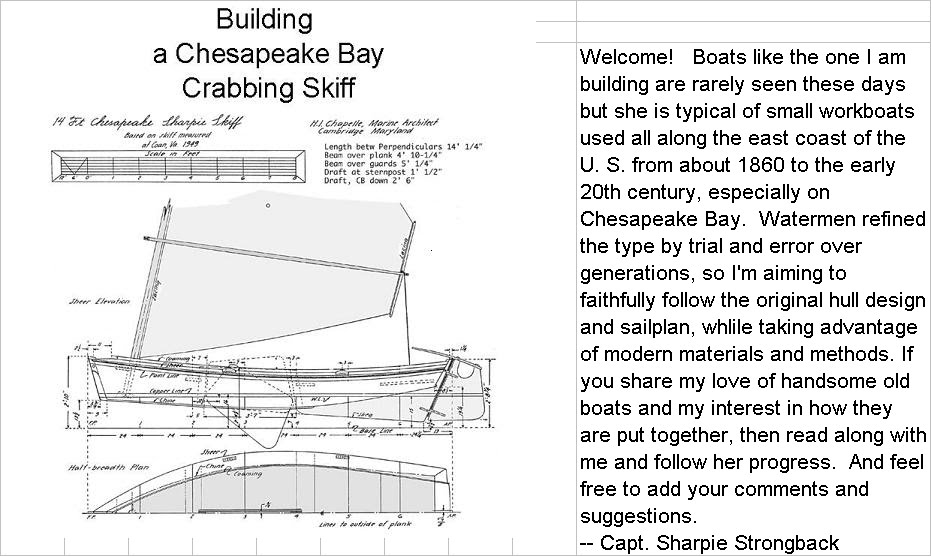
12-24 The Moaning Chair:
In every amateur boatbuilder’s shop there should be a “moaning chair”; this should be a comfortable seat from which the boat can be easily seen and in which the builder can sit, smoke, chew, drink, or swear as the moment demands.
Howard I. Chapelle, Boatbuilding
I needed the moaning chair early and often this Christmas Eve. During the night before, it occurred to me I had set up two of the molds wrong. They were too far aft by the thickness of the plywood. So the first project of the day was to take those molds apart and put them up right. The one remaining station mold (#6) went up smoothly, but getting the transom pattern in the right place took the rest of the day. It needed to be centered, straight up and down, straight across, and at the right height and angle, all at the same time. Adjusting any one thing threw everything else off. None of my books suggested how to control the pattern in all three dimensions at the same time, but I finally did figure out how, and it was satisfying to get that job done.
Eyeballing what I thought were the completed molds revealed a problem which took me back to the moaning chair. The #6 mold just forward of the transom will clearly not give a fair curve to the side or the bottom. At first I assumed I measured, cut or mounted the mold wrong, since the only other possibility is that the boat's designer quoted above, Howard Chapelle, despite his iconic reputation as a marine architect and maritime historian, made a mistake on the offsets which specified the shape of the mold. Nevertheless, a careful remeasurement of the mold confirmed that he indeed had feet of clay. The photo from the stern shows the offending mold, with the fairing battens hanging out in the air. It also shows my moaning chair in the background. It will not be difficult to adjust the mold so the hull is shaped like the plan, even if it doesn't match the offsets at that point, but how the mistake might have been made remains a mystery.
In every amateur boatbuilder’s shop there should be a “moaning chair”; this should be a comfortable seat from which the boat can be easily seen and in which the builder can sit, smoke, chew, drink, or swear as the moment demands.
Howard I. Chapelle, Boatbuilding
I needed the moaning chair early and often this Christmas Eve. During the night before, it occurred to me I had set up two of the molds wrong. They were too far aft by the thickness of the plywood. So the first project of the day was to take those molds apart and put them up right. The one remaining station mold (#6) went up smoothly, but getting the transom pattern in the right place took the rest of the day. It needed to be centered, straight up and down, straight across, and at the right height and angle, all at the same time. Adjusting any one thing threw everything else off. None of my books suggested how to control the pattern in all three dimensions at the same time, but I finally did figure out how, and it was satisfying to get that job done.
Eyeballing what I thought were the completed molds revealed a problem which took me back to the moaning chair. The #6 mold just forward of the transom will clearly not give a fair curve to the side or the bottom. At first I assumed I measured, cut or mounted the mold wrong, since the only other possibility is that the boat's designer quoted above, Howard Chapelle, despite his iconic reputation as a marine architect and maritime historian, made a mistake on the offsets which specified the shape of the mold. Nevertheless, a careful remeasurement of the mold confirmed that he indeed had feet of clay. The photo from the stern shows the offending mold, with the fairing battens hanging out in the air. It also shows my moaning chair in the background. It will not be difficult to adjust the mold so the hull is shaped like the plan, even if it doesn't match the offsets at that point, but how the mistake might have been made remains a mystery.
I have to report one other incident which took me back to the moaning chair. While working on the transom, I stepped around the end of the strongback, grapped a timber for support, and realized too late it wasn’t attached to anything. The transom, a handful of tools, the power drill and I all went over the seawall into the bay. Fortunately it was only knee deep, and even more fortunately, no one saw.
Work will resume after a trip out of town for the New Year.




